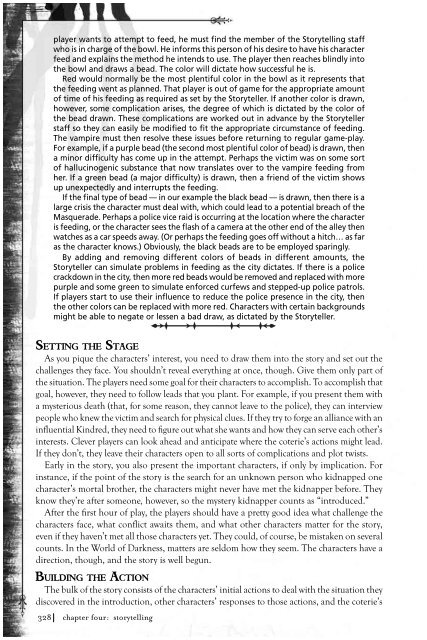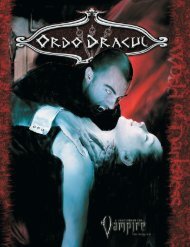Mind's Eye Theatre - Vampire The Requiem.pdf - RoseRed
Mind's Eye Theatre - Vampire The Requiem.pdf - RoseRed
Mind's Eye Theatre - Vampire The Requiem.pdf - RoseRed
Create successful ePaper yourself
Turn your PDF publications into a flip-book with our unique Google optimized e-Paper software.
player wants to attempt to feed, he must fi nd the member of the Storytelling staff<br />
who is in charge of the bowl. He informs this person of his desire to have his character<br />
feed and explains the method he intends to use. <strong>The</strong> player then reaches blindly into<br />
the bowl and draws a bead. <strong>The</strong> color will dictate how successful he is.<br />
Red would normally be the most plentiful color in the bowl as it represents that<br />
the feeding went as planned. That player is out of game for the appropriate amount<br />
of time of his feeding as required as set by the Storyteller. If another color is drawn,<br />
however, some complication arises, the degree of which is dictated by the color of<br />
the bead drawn. <strong>The</strong>se complications are worked out in advance by the Storyteller<br />
staff so they can easily be modifi ed to fi t the appropriate circumstance of feeding.<br />
<strong>The</strong> vampire must then resolve these issues before returning to regular game-play.<br />
For example, if a purple bead (the second most plentiful color of bead) is drawn, then<br />
a minor diffi culty has come up in the attempt. Perhaps the victim was on some sort<br />
of hallucinogenic substance that now translates over to the vampire feeding from<br />
her. If a green bead (a major diffi culty) is drawn, then a friend of the victim shows<br />
up unexpectedly and interrupts the feeding.<br />
If the fi nal type of bead — in our example the black bead — is drawn, then there is a<br />
large crisis the character must deal with, which could lead to a potential breach of the<br />
Masquerade. Perhaps a police vice raid is occurring at the location where the character<br />
is feeding, or the character sees the fl ash of a camera at the other end of the alley then<br />
watches as a car speeds away. (Or perhaps the feeding goes off without a hitch… as far<br />
as the character knows.) Obviously, the black beads are to be employed sparingly.<br />
By adding and removing different colors of beads in different amounts, the<br />
Storyteller can simulate problems in feeding as the city dictates. If there is a police<br />
crackdown in the city, then more red beads would be removed and replaced with more<br />
purple and some green to simulate enforced curfews and stepped-up police patrols.<br />
If players start to use their infl uence to reduce the police presence in the city, then<br />
the other colors can be replaced with more red. Characters with certain backgrounds<br />
might be able to negate or lessen a bad draw, as dictated by the Storyteller.<br />
SETTING THE STAGE<br />
As you pique the characters’ interest, you need to draw them into the story and set out the<br />
challenges they face. You shouldn’t reveal everything at once, though. Give them only part of<br />
the situation. <strong>The</strong> players need some goal for their characters to accomplish. To accomplish that<br />
goal, however, they need to follow leads that you plant. For example, if you present them with<br />
a mysterious death (that, for some reason, they cannot leave to the police), they can interview<br />
people who knew the victim and search for physical clues. If they try to forge an alliance with an<br />
infl uential Kindred, they need to fi gure out what she wants and how they can serve each other’s<br />
interests. Clever players can look ahead and anticipate where the coterie’s actions might lead.<br />
If they don’t, they leave their characters open to all sorts of complications and plot twists.<br />
Early in the story, you also present the important characters, if only by implication. For<br />
instance, if the point of the story is the search for an unknown person who kidnapped one<br />
character’s mortal brother, the characters might never have met the kidnapper before. <strong>The</strong>y<br />
know they’re after someone, however, so the mystery kidnapper counts as “introduced.”<br />
After the fi rst hour of play, the players should have a pretty good idea what challenge the<br />
characters face, what confl ict awaits them, and what other characters matter for the story,<br />
even if they haven’t met all those characters yet. <strong>The</strong>y could, of course, be mistaken on several<br />
counts. In the World of Darkness, matters are seldom how they seem. <strong>The</strong> characters have a<br />
direction, though, and the story is well begun.<br />
BUILDING THE ACTION<br />
<strong>The</strong> bulk of the story consists of the characters’ initial actions to deal with the situation they<br />
discovered in the introduction, other characters’ responses to those actions, and the coterie’s<br />
328<br />
mind’s chapter eye four: theatre: storytelling requiem



